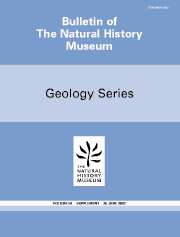Article contents
The Lower Lias of Robin Hood's Bay, Yorkshire, and the work of Leslie Bairstow
Published online by Cambridge University Press: 31 October 2002
Abstract
Introduction 82
Leslie Bairstow 82
Biography 82
Bairstow's unpublished work 84
Geological maps 84
Geological structure of Robin Hood's Bay 93
Stratigraphical succession 93
Bed numbers 95
Detailed succession in Robin Hood's Bay 96
Lithostratigraphy 111
Staithes Sandstone Formation 111
Redcar Mudstone Formation 111
Exposures in Robin Hood's Bay now 114
Correlation with previous descriptions 114
Bairstow's ammonite collection 115
Systematic description of the ammonites and nautiloids 118
Family Juraphyllitidae 118
Family Lytoceratidae 118
Family Psiloceratidae 119
Family Schlotheimidae 119
Family Arietitidae 119
Subfamily Arietitinae 119
Subfamily Agassiceratinae 123
Subfamily Asteroceratinae 123
Family Echioceratidae 125
Family Oxynoticeratidae 129
Family Cymbitidae 132
Family Eoderoceratidae 132
Family Coeloceratidae 136
Family Phricodoceratidae 137
Family Polymorphitidae 137
Family Liparoceratidae 141
Family Nautilidae 144
Biostratigraphy 144
Acknowledgements 150
References 150
Rocks of Lower Liassic (Sinemurian and Lower Pliensbachian) age exposed in Robin Hood's Bay, near Whitby, north Yorkshire, are described from the mapping, stratigraphical descriptions and ammonite collections made by Mr Leslie Bairstow in the years 1927–1970, and preserved in the Palaeontology Department, The Natural History Museum, London. His large-scale map of the geology of the foreshore is published on five sheets at a scale of approximately 1:5000. The stratigraphical sequence from bed 418 at the base up to bed 600.5 at the top of the Lower Pliensbachian is 163.74 m thick, and consists of the Redcar Mudstone Formation, for which four members are formally defined – the Calcareous Shale (at the base), Siliceous Shale, Pyritous Shale and Ironstone Shale Members – overlain by the lower part of the Staithes Sandstone Formation. The lowest beds exposed by the lowest spring tides are Sauzeanum Subzone, Semicostatum Zone, in age; ammonites occur in all subzones, and the only uncertain boundary is that between the Masseanum and Valdani Subzones (Ibex Zone), where there are few characteristic ammonites. Bairstow's ammonite collection consists of more than 2360 specimens, all from recorded horizons, and is notably rich in Promicroceras, Asteroceras, Eparietites and Oxynoticeras from the Obtusum and Oxynotum Zones, Echioceratids, Eoderoceras and Apoderoceras from the Oxynotum, Raricostatum and Jamesoni Zones, and Liparoceratids from the Davoei Zone, making it a primary source for Sinemurian and Lower Pliensbachian ammonite biostratigraphy. The recently proposed selection of Wine Haven at the south-eastern end of the bay as the Global Stratotype Section and Point (GSSP) for the base of the Pliensbachian Stage (ie. the world standard definition), is supported by the sequence of ammonites across the Sinemurian/Pliensbachian boundary. All previously figured ammonites from Robin Hood's Bay are listed in a systematic section that includes the evidence on which the ammonite identifications in the paper are based, and 56 of the best preserved ammonites are figured. Eparietites bairstowi sp. nov. is proposed for an early species of Eparietites and a Sowerby Collection ammonite from the Aplanatum Subzone, Raricostatum Zone, in the bay, is designated neotype of Eoderoceras armatum (J. Sowerby).
- Type
- Research Article
- Information
- Bulletin of the Natural History Museum: Geology Series , Volume 58 , Issue 2 , 28 November 2002 , pp. 81 - 152
- Copyright
- © The Natural History Museum, 2002
- 6
- Cited by


